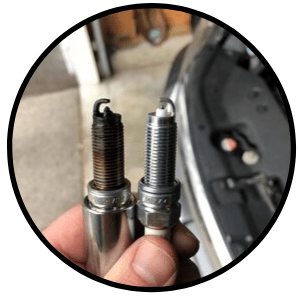Understanding Spark Plugs
In your vehicle’s engine, spark plugs play a crucial role in ignition, directly impacting engine performance and efficiency.
Purpose of Spark Plugs
- Initiate Combustion: Spark plugs are responsible for igniting the air/fuel mixture in the combustion chamber.
- Transfer Heat: They transfer excess heat from the combustion chamber to the engine’s cooling system.
Signs of Worn Spark Plugs
You might notice several indicators that your spark plugs are due for replacement:
- Reduced Fuel Economy: Your vehicle might consume more fuel than usual.
- Engine Misfires: Intermittent stumbling or sputtering indicates that combustion is not occurring properly.
- Difficulty Starting: Your engine struggles or takes longer to start, especially in cold weather.
- Poor Acceleration: If your car doesn’t respond promptly or feels sluggish when you accelerate, it could be a spark plug issue.
Preparing for Replacement

Replacing spark plugs is a straightforward process, but proper preparation ensures that you can complete the task efficiently and safely. Gather the correct tools and materials, and familiarize yourself with safety procedures.
Tools and Materials
Before you start, ensure you have the following items:
- Spark plug socket: specifically designed to fit your vehicle’s spark plugs
- Ratchet and extension: for ease of removal and installation
- Torque wrench: to tighten the spark plugs to the manufacturer’s specifications
- Gap gauge: to check and adjust the spark plug gap if necessary
- New spark plugs: matched to your vehicle’s make and model
- Anti-seize compound: to apply to the threads of new spark plugs (if recommended by the manufacturer)
- Dielectric grease: for the spark plug boot to prevent sticking and corrosion
Safety Precautions
Your safety is paramount. Remember to:
- Wear Safety Glasses: Protect your eyes from debris.
- Cool Down the Engine: Wait for the engine to cool before starting to prevent burns.
- Disconnect the Battery: Always start by disconnecting the negative terminal to avoid electrical shocks.
- Work in a Well-Ventilated Area: Ensure good air circulation to avoid inhaling fumes.
- Keep a Fire Extinguisher Nearby: Be prepared for any accidental sparks or fires.
Remember, careful preparation paves the way for a successful spark plug replacement.
Removing Old Spark Plugs

Before you start, ensure your vehicle’s engine is cold to avoid injury, as spark plugs can get very hot.
Tools Needed:
- Spark plug socket
- Ratchet or T-bar
- Extension bar (if necessary)
- Spark plug gap tool (for reinstalling)
- Torque wrench (for reinstalling)
Procedure:
- Locate the spark plugs: Your vehicle’s manual will indicate where to find them; typically, they’re attached to thick rubbery wires.
- Remove the spark plug wires: Gently twist and pull the boot (the end of the wire) to avoid tearing. Tag the wires if necessary to remember their order.
- Clean the area: Use a compressed air can or a brush to remove any debris around the spark plug. This prevents contamination of the engine when the plug is removed.
- Loosen the spark plug: Attach the spark plug socket to your ratchet or T-bar and place it over the spark plug. Turn counter-clockwise to loosen. An extension bar may be necessary if the spark plugs are recessed.
- Remove the spark plug: Once loose, you can unscrew it by hand. Remove it carefully and inspect it to judge your engine’s condition.
Helpful Tips:
- Do not force the spark plugs if they’re difficult to remove. This could strip the thread.
- Consult your vehicle’s manual for the correct order of operations.
- If a spark plug is stuck, spraying a little penetrating oil can assist with loosening.
Next Steps: Once the old spark plugs are out, inspect the cavity for damage or debris before installing new spark plugs. Follow the manufacturer’s specifications for proper installation.
Installing New Spark Plugs
Before you begin, make sure you have the correct type and number of spark plugs as specified by your vehicle manufacturer. Proper gapping and torque are crucial to spark plug performance.
Gap Adjustment
- Check the gap on new spark plugs using a gap gauge.
- Adjust the gap by carefully bending the side electrode.
- Consult your vehicle’s specifications for the proper gap measurement.
Torque Specifications
- Thread the spark plug by hand until it’s seated to avoid cross-threading.
- Use a torque wrench to tighten the spark plug to the manufacturer’s recommended torque value.
- Over-tightening can damage the plug; under-tightening can cause it to loosen.
Post-Installation Checks
After installing new spark plugs, it’s crucial to review everything to ensure your vehicle runs smoothly.
- Start your engine: It should fire up smoothly. Any unusual noises or a rough start suggests a problem.
- Rev the engine: Listen for misfires indicating a loose spark plug wire or improper gapping.
- Inspect for leaks: Look around the spark plug for any oil or coolant leaks.
Check the following:
- Ignition wires: Ensure they are securely connected. Poor connections can lead to misfires.
- Electrical connections: They must be tight and corrosion-free.
- Engine idling: Your car should idle steadily. Irregular idling can signify incorrect plug installation.
Additional tips:
- Use a torque wrench: To avoid over-tightening, a torque wrench aligns with the manufacturer’s specifications.
- Clear any codes: Scan for error codes and clear them after the new plugs are installed.
Routine follow-up:
- Performance monitoring: Watch for any changes in fuel efficiency and engine performance.
- Subsequent inspection: Re-check spark plug connections after a few miles as a precaution.
Remember, these checks are a key step in ensuring that your vehicle benefits from the maintenance work just performed.
